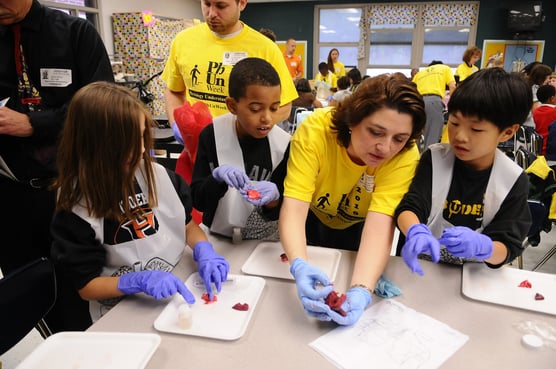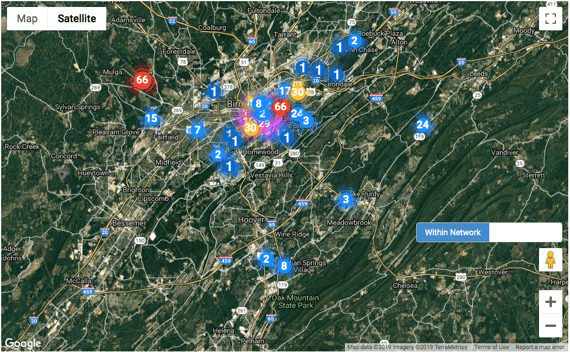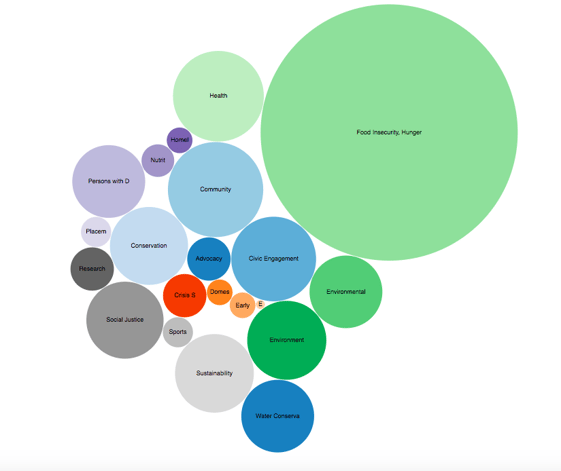This post is part of our Spotlight series, where we spotlight our incredible partners. We are so thrilled that GivePulse has been able to work with these nonprofits, institutions, and corporations!
Bringing Community to the University

UAB volunteers teach elementary school students about physiology
The vision statement of the University of Alabama at Birmingham affirms the university’s dedication to “inspiring and empowering the creation of knowledge that changes the world.” This is perhaps natural given UAB’s location in a city historically invested in community change. Emily Wykle, project director in the Office of the President at UAB, emphasizes the importance of Birmingham’s “really deep commitment” to community engagement. The city itself offers “very fertile ground” for civic work, she says, adding, “You don’t have to be browbeating people to get involved. You have the appetite.”
This city-wide energy for community change is evident in UAB’s broadly reaching implementation of GivePulse. UAB established their GivePulse domain (dubbed “BlazerPulse”) in the fall of 2018. According to Wykle, GivePulse has been “kind of the overlay” for the city’s work. “There’s already exciting things happening,” she notes. With GivePulse, the university can “give others a way in.”
“There’s already exciting things happening,” Wykle says. GivePulse can “give others a way in.”
Before using GivePulse, connections between the university and community change efforts already underway were sometimes, in Wykle’s words, “kind of random.” Faculty members looking for organizations with which to engage often experienced difficulty in locating the greatest community need, while community partners did not always know how to access the university’s resources. In addition, to track data, UAB used “a kind of homegrown survey that I don’t think I would be speaking out of turn to say was a big disaster. There was no way to analyze it, not a great response rate.”

The “cluster” view of various UAB activities happening in Birmingham
GivePulse provides resources that analyze both qualitative and quantitative information. One example that Wykle sees as particularly beneficial is the engagement heat map, which she says “gets people so excited, and I think that’s really driven a lot of exciting partnerships.” She recalls working with Hands on Birmingham, a United Way sponsored organization, for their Back to School Beautification Day. The UAB community was invited alongside the broader Birmingham community to work with people in the neighborhoods where each of the city’s schools were housed. Wykle considers this a key facet of being part of the various communities in Birmingham: “This has been a way for us to work alongside them. A more opportune way.”
“[GivePulse] gets people so excited, and I think that’s really driven a lot of exciting partnerships.”
Mutually Beneficial Partnerships
Through GivePulse, the question of how to create a mutually beneficial partnership for community change is answered by design. Community partners can see the forms of engagement supported by UAB and can open aligned opportunities; in turn, students, faculty, and staff at UAB are able to find and engage with the opportunities that most need their help.

UAB students gain hands-on knowledge of farming in Birmingham
In this way, UAB has found in GivePulse “essentially a civic giving form” through which community partners and nonprofits can consider how to connect their needs to the strategic goals of the university. UAB, meanwhile, can see both “the strategic connection” and “whether that organization is invested in what [UAB is] doing.” This helps UAB “to make better decisions around who [they] support, and also democratizes the process.” Any nonprofits can sign up on GivePulse; no longer reliant on hearing about engagement opportunities through connections and networking, nonprofits now have a “front door” to the resources of the university.

A bubble chart showing UAB engagement by specific causes
GivePulse helps UAB “to make better decisions around who [they] support, and also democratizes the process.”
In addition to accessing information about the possibilities available, UAB can now also see the work with which staff and students have already been engaging. Wykle recalls using the system to determine who had logged the most hours on BlazerPulse and finding a woman who, unbeknownst to Wykle, had been working night shifts at a crisis center. This user logged more than 700 hours with the center. Through GivePulse, this record was suddenly easily accessible, allowing UAB to “highlight her and recognize her for her work.” Furthermore, this knowledge allowed UAB to strengthen connections with the crisis center, helping more volunteers to engage in this work.
Community Energy for Change
UAB brought community partners onto GivePulse “really early, like before we really knew what we were doing,” recalls Wykle, adding, “I can’t believe we did that!” UAB organized a meeting with about fifty nonprofits in Birmingham that they had “deep relationships with, deep history” — nonprofits that the university knew “would go out on a limb” for them. Community partners soon began to expand their presence on GivePulse. Now, they are not just “using it for UAB,” Wykle says. “They’re really using it to get volunteers to sign up from other parts of Birmingham.”
Nonprofits are really using GivePulse “to get volunteers to sign up from other parts of Birmingham.”
UAB maintains the energy for community change that first brought the partners to GivePulse by meeting with them twice a year, which, particularly in the early days of using GivePulse, offered an opportunity to hear what was — and was not — working. Wykle recalls learning that the Office of Conduct, when assigning students community service, did not count GivePulse as a valid way to track service hours, something that she would not have known had community partners not brought this to her attention. This opened an opportunity to have a conversation with the Office of Conduct, resulting in the confirmation of GivePulse as the primary method of tracking service hours across the campus.
Campus-Wide Implementation
Since implementing GivePulse in fall of 2018, UAB has created over 200 subgroups and recorded over 30,000 hours of community activity. While these numbers might seem overwhelming to build into any platform, UAB maintains an organizational system that calls upon feedback from across the institution. Wykle emphasizes the importance of building a system of liaisons across departments, colleges, and organizations on campus, all of whom can offer feedback throughout the implementation process. At the start, “there were some hiccups,” but with the help of a diverse group of faculty members, UAB was “able to say, ‘Here’s where faculty are getting stuck, here’s what’s sticky.’”
Wykle also emphasizes the importance of support at the top tier of the institution; because she works in the president’s office, the engagement “has really has come from the top down.” This is critical: “Having it come from the top down gives it a sense of [being] something we are really committed to and interested in.” Perhaps more importantly, every department and college at the school is focused on community engagement. “Each of the schools has a community engagement part of their strategic plan,” she says, and adds, “We can meet them where they’re at… [it’s] not just a central helping us kind of thing, but can help at a school and department level.” While each department and college may have had different practices of engagement prior to the implementation of GivePulse, centralizing the data and the tracking system allows for these different colleges to share knowledge, opening the university to stronger engagement for community change in every field.
It helped that faculty members immediately recognized the need for this platform from their own experiences with community engagement. As Wykle notes, “They were going to be with us from the outset. This was something that was important to them.” This was true both of faculty members whose time was spent primarily in the classroom and of faculty whose focus was primarily on research. The latter group is important to UAB: “We are a research university,” Wykle says, adding that it is important to the university to figure out how GivePulse can “help you leverage the research and work you’re already doing and use it to translate… [to] actual value in people’s lives.” The main question UAB still hopes to answer, she adds, is, “How are we taking the teaching, research, all of the knowledge being generated here, and [translating] it to making people’s lives better in Birmingham?” Accentuating this focus for the research side of the university supports UAB’s vision of changing the world through acquisition and creation of knowledge.
It is important to the university to figure out how GivePulse can “help you leverage the research and work you’re already doing and use it to translate… [to] actual value in people’s lives.”
While faculty interest and recognition of the valuable ways GivePulse could be used were critical when establishing the platform, Wykle feels that equally crucial to successful implementation was positive student response. Students quickly adopted GivePulse, providing feedback and recording hours at a rate that surprised even the most enthusiastic faculty members. Because of their consistent use of GivePulse, students create data containing detailed information that UAB can use to understand how and why they are interacting with the Birmingham community.
When asked if she had any advice for other universities implementing GivePulse, Wykle says, “If we had waited until everything was flawless and then invited community partners in, that would have been a major misstep.” Instead of waiting until their implementation seemed perfect, UAB was “really honest about building the plan,” asking for feedback and input from community partners, students, faculty, and staff throughout the process. Ultimately, it comes down to seeking feedback from a variety of sources to ensure that everyone — community partners, students, faculty, staff — can engage in a way that changes the community for the better. As Wykle advises, “Don’t let the perfect be the enemy of the good.”
To discuss how GivePulse can help your institution make an impact in your community, schedule a call with our higher education team.

